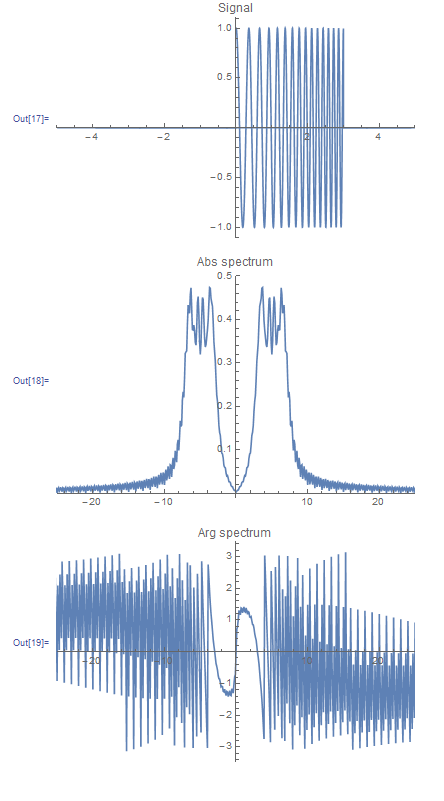I am calculating the phase spectrum of a linear chirped signal. I actually don't know how the phase spectrum should be, but I would expect something in the range of interest (the bandwidth) at least to behave smoothly. This is what I obtain:
(*Define the time range and the number of sample points,this \
determines the frequency range and resolution.In order for the \
fftshift function to work properly,the number of sample points should \
be even.*)
trange = 10.0;
num = 2^12;
dt = trange/num;
df = 1/(num dt);
fftshift[flist_] := RotateRight[flist, (Length@flist)/2 - 1];
signal[t_] :=
Cos[initialPhase +
2*Pi*(chirpInitialFrequency*t + (chirpLinearRate/2)*
t^2)]*(UnitStep[t] - UnitStep[t - 3.0])
initialPhase = 0.0;
chirpFrequencyCenter = 5.0;
chirpBandwidth = 5.0;
chirpInitialFrequency = chirpFrequencyCenter - chirpBandwidth/2;
chirpFinalFrequency = chirpFrequencyCenter + chirpBandwidth/2;
chirpDuration = 3.0;
chirpLinearRate = (chirpFinalFrequency - chirpInitialFrequency)/
chirpDuration;
(*Now define the sampled signal in the time domain*)
xValuesSampledSignal :=
RotateLeft[Table[t, {t, -dt num/2 + dt, num/2 dt, dt}], num/2 - 1];
yValuesSampledSignal = signal /@ xValuesSampledSignal;
(*Then define the spectrum,and plot the signal along with the \
amplitude and phase of the spectrum*)
yValuesDiscreteFourierTransform =
fftshift[Fourier[yValuesSampledSignal,
FourierParameters -> {1, -1}]];
ListLinePlot[Transpose[{xValuesSampledSignal, yValuesSampledSignal}],
PlotRange -> {{-5, 5}, All}, PlotLabel -> "Signal"]
ListLinePlot[Abs[dt yValuesDiscreteFourierTransform],
DataRange -> df {-num/2 + 1, num/2}, PlotRange -> {{-25, 25}, All},
PlotLabel -> "Abs spectrum"]
ListLinePlot[Arg[dt yValuesDiscreteFourierTransform],
DataRange -> df {-num/2 + 1, num/2}, PlotRange -> {{-25, 25}, All},
PlotLabel -> "Arg spectrum"]
The magnitude spectrum seems correct. I think the routine to calculate the spectrum is correct, it works well with other more simple signals.


